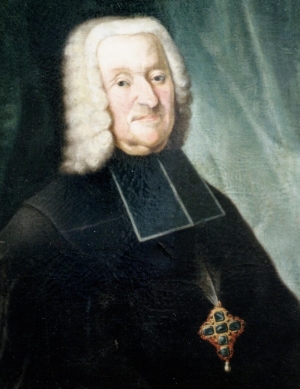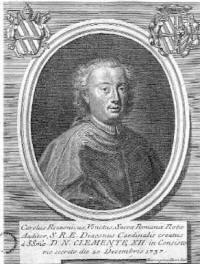|
Joseph Ignaz Philipp Von Hessen-Darmstadt
Joseph Ignaz Philipp of Hesse-Darmstadt (1699–1768) was the Prince-Bishop of Augsburg from 1740 to 1768. Early life Landgrave Joseph Ignaz Philipp of Hesse-Darmstadt was born in Brussels on 22 January 1699, the son of Philip of Hesse-Darmstadt and his wife Princess Marie Ernestine of Croy-Havré (1673–1714), second daughter of Ferdinand Joseph von Croÿ, 3rd Duke of Havré (1644–1694). He was raised partially in Mantua. Biography He was ordained as a priest in Augsburg on 13 March 1729. The cathedral chapter of Augsburg Cathedral elected him to be Prince-Bishop of Augsburg on 18 August 1740 and Pope Benedict XIV confirmed this appointment on 2 January 1741. He was subsequently consecrated as a bishop by Johann Jakob von Mayr, auxiliary bishop of Augsburg, on 12 February 1741. On 29 April 1764 the cathedral chapter of Augsburg Cathedral elected Prince Clemens Wenceslaus of Saxony as his coadjutor bishop, an appointment approved by Pope Clement XIII only on the cond ... [...More Info...] [...Related Items...] OR: [Wikipedia] [Google] [Baidu] |
Joseph Ignaz Philipp Von Hessen-Darmstadt
Joseph Ignaz Philipp of Hesse-Darmstadt (1699–1768) was the Prince-Bishop of Augsburg from 1740 to 1768. Early life Landgrave Joseph Ignaz Philipp of Hesse-Darmstadt was born in Brussels on 22 January 1699, the son of Philip of Hesse-Darmstadt and his wife Princess Marie Ernestine of Croy-Havré (1673–1714), second daughter of Ferdinand Joseph von Croÿ, 3rd Duke of Havré (1644–1694). He was raised partially in Mantua. Biography He was ordained as a priest in Augsburg on 13 March 1729. The cathedral chapter of Augsburg Cathedral elected him to be Prince-Bishop of Augsburg on 18 August 1740 and Pope Benedict XIV confirmed this appointment on 2 January 1741. He was subsequently consecrated as a bishop by Johann Jakob von Mayr, auxiliary bishop of Augsburg, on 12 February 1741. On 29 April 1764 the cathedral chapter of Augsburg Cathedral elected Prince Clemens Wenceslaus of Saxony as his coadjutor bishop, an appointment approved by Pope Clement XIII only on the cond ... [...More Info...] [...Related Items...] OR: [Wikipedia] [Google] [Baidu] |
Bishop
A bishop is an ordained clergy member who is entrusted with a position of authority and oversight in a religious institution. In Christianity, bishops are normally responsible for the governance of dioceses. The role or office of bishop is called episcopacy. Organizationally, several Christian denominations utilize ecclesiastical structures that call for the position of bishops, while other denominations have dispensed with this office, seeing it as a symbol of power. Bishops have also exercised political authority. Traditionally, bishops claim apostolic succession, a direct historical lineage dating back to the original Twelve Apostles or Saint Paul. The bishops are by doctrine understood as those who possess the full priesthood given by Jesus Christ, and therefore may ordain other clergy, including other bishops. A person ordained as a deacon, priest (i.e. presbyter), and then bishop is understood to hold the fullness of the ministerial priesthood, given responsibility b ... [...More Info...] [...Related Items...] OR: [Wikipedia] [Google] [Baidu] |
1699 Births
Events January–March * January 5 – A violent Java earthquake damages the city of Batavia on the Indonesian island of Java, killing at least 28 people * January 20 – The Parliament of England (under Tory dominance) limits the size of the country's standing army to 7,000 'native born' men; hence, King William III's Dutch Blue Guards cannot serve in the line. By an Act of February 1, it also requires disbandment of foreign troops in Ireland. * January 26 – The Republic of Venice, Polish–Lithuanian Commonwealth and Holy Roman Empire sign the Treaty of Karlowitz with the Ottoman Empire, marking an end to the major phase of the Ottoman–Habsburg wars. The treaty marks a major geopolitical shift, as the Ottoman Empire subsequently abandons its expansionism and adopts a defensive posture while the Habsburg monarchy expands its influence. * February 3 – The first paper money in America is issued by the colony of Massachusetts, to pay its soldiers fighting against Queb ... [...More Info...] [...Related Items...] OR: [Wikipedia] [Google] [Baidu] |
Johann Franz Schenk Von Stauffenberg
Johann Franz Schenk von Stauffenberg (1658–1740) was Prince-Bishop of Constance from 1704 to 1740 and Prince-Bishop of Augsburg from 1737 to 1740. Early life Johann Franz Schenk von Stauffenberg was born in Lautlingen on 18 February 1658 as the fourth son of Wolfgang Friedrich Schenk von Stauffenberg (1612-1676) and his wife, Anna Barbara von Wernau (1632-1681). Biography He was made a canon of Konstanz Cathedral in 1667. He studied in Dillingen an der Donau until 1675. His father died in 1676 and his mother at 1681, after which time his uncles Hans Georg von Wernau and Franz Wilhelm von Stain acted as his guardians. He became a canon of Augsburg Cathedral in 1682. In 1694, he became coadjutor bishop of Constance. Upon the death of Marquard Rudolf von Rodt, Bishop of Constance, on 10 June 1704, he succeeded as Bishop of Constance. He was ordained as a priest on 11 November 1704. On 26 January 1705 Pope Clement XI confirmed his appointment and he was subsequently consecrate ... [...More Info...] [...Related Items...] OR: [Wikipedia] [Google] [Baidu] |
Plombières-les-Bains
Plombières-les-Bains () is a commune in the Vosges department in Grand Est in eastern France. It was the seat of the former canton of Plombières-les-Bains. ''Les bains'' refers to the hot springs in the area, whose properties were first discovered by the Romans. In succeeding centuries, its baths were visited by Montaigne, Voltaire, the Dukes of Guise, the Dukes of Lorraine, Beaumarchais, Napoleon Bonaparte, Joséphine de Beauharnais, Napoléon III, Berlioz, Lamartine and Alfred de Musset. It is still a spa town with many buildings from the Second French Empire including the Church Saint Amé built with the financial support of Napoléon III. Plombières Agreement The "Pavilion of the Princes" at Plombières, was renamed following the meeting on 21 July 1858 between Napoleon III and Camillo Benso, Count of Cavour, who secretly negotiated the “ Plombières Agreement” as they sat alone together in a small horse-drawn carriage slowly progressing round and round the t ... [...More Info...] [...Related Items...] OR: [Wikipedia] [Google] [Baidu] |
Prince-Bishop Of Regensburg
The Bishops of Regensburg (Ratisbon) are bishops of the Roman Catholic Diocese of Regensburg, Bavaria, Germany."Diocese of Regensburg" ''''. David M. Cheney. Retrieved February 29, 2016"Diocese of Regensburg" ''GCatholic.org''. Gabriel Chow. Retrieved February 29, 2016 The seat of the bishops is . History Th ...[...More Info...] [...Related Items...] OR: [Wikipedia] [Google] [Baidu] |
Prince-Bishop Of Freising
The following people were bishops, prince-bishops or archbishops of Freising or Munich and Freising in Bavaria: Bishops of Freising * St. Corbinian (724–730); founded the Benedictine abbey in Freising, although the diocese was not organized until 739) : Establishment of episcopal organisation in Old Bavaria by Saint Boniface in 739. * Erembert (739–747/748; sometimes referred to as Corbinian's half brother) * Joseph of Freising, also known as Joseph of Verona (747/748–764) * Arbeo (764–783/784) * Atto (783/784–810/811) * Hitto (810/811–834/835) * Erchanbert (835/836–854) * Anno (854/855–875) * Arnold (875–883) * Waldo (883/884–903/906) * Utto (904/906–907) * Dracholf (907–926) * Wolfram (926–937) * St. Lantpert (937/938–957) * Abraham (956/957–993/994) * Gottschalk of Hagenau (994–1005) * Egilbert of Moosburg (1005–1039) * Nitker (1039–1052) * Ellenhard, Count of Meran (1052–1078) * Meginward, Count of Scheyarn (1078� ... [...More Info...] [...Related Items...] OR: [Wikipedia] [Google] [Baidu] |
Pope Clement XIII
Pope Clement XIII ( la, Clemens XIII; it, Clemente XIII; 7 March 1693 – 2 February 1769), born Carlo della Torre di Rezzonico, was head of the Catholic Church and ruler of the Papal States from 6 July 1758 to his death in February 1769. He was installed on 16 July 1758. His pontificate was overshadowed by the constant pressure to suppress the Society of Jesus but despite this, he championed their order and also proved to be their greatest defender at that time. He was also one of the few early popes who favoured dialogue with Protestants and to this effect hoped to mend the schism with the Catholic Church that existed in England and the Low Countries. These efforts ultimately bore little fruit. Biography Early life Carlo della Torre di Rezzonico was born in 1693 to a recently ennobled family of Venice, the second of two children of the man who bought the unfinished palace on the Grand Canal (now Ca' Rezzonico) and finished its construction. His parents were Giovanni Ba ... [...More Info...] [...Related Items...] OR: [Wikipedia] [Google] [Baidu] |
Coadjutor Bishop
A coadjutor bishop (or bishop coadjutor) is a bishop in the Catholic, Anglican, and (historically) Eastern Orthodox churches whose main role is to assist the diocesan bishop in the administration of the diocese. The coadjutor (literally, "co-assister" in Latin) is a bishop himself, although he is also appointed as vicar general. The coadjutor bishop is, however, given authority beyond that ordinarily given to the vicar general, making him co-head of the diocese in all but ceremonial precedence. In modern times, the coadjutor automatically succeeds the diocesan bishop upon the latter's retirement, removal, or death. Catholic Church In the Catholic Church, a coadjutor is a bishop with papal appointment as an immediate collaborator of the diocesan bishop in the governance of a diocese, with authority to substitute for the diocesan bishop in his absence and right to automatic succession to the diocesan see upon death, resignation, or transfer of the incumbent diocesan bishop. T ... [...More Info...] [...Related Items...] OR: [Wikipedia] [Google] [Baidu] |
Prince Clemens Wenceslaus Of Saxony
Prince Clemens Wenceslaus of Saxony (German: ''Clemens Wenzeslaus August Hubertus Franz Xaver von Sachsen'') (28 September 1739 – 27 July 1812) was a Saxon prince from the House of Wettin and the Archbishop-Elector of Trier from 1768 until 1803, the Prince-Bishop of Freising from 1763 until 1768, the Prince-Bishop of Regensburg from 1763 until 1769, and the Prince-Bishop of Augsburg from 1768 until 1812. Biography Clemens Wenceslaus was the ninth child of the Prince-Elector Augustus III of Saxony, who was also the King of Poland. In 1760 he went to Vienna and entered the Austrian army as a field marshal. He was present at the Battle of Torgau (3 November 1760), but he decided that warfare was not for him and instead entered the church. On 18 and 27 April 1763 he was elected the Bishops of Freising and Regensburg, respectively, but he abandoned these dioceses for the Archbishopric-Electorate of Trier and the Prince-Bishopric of Augsburg in February and August 1768, respectively ... [...More Info...] [...Related Items...] OR: [Wikipedia] [Google] [Baidu] |





